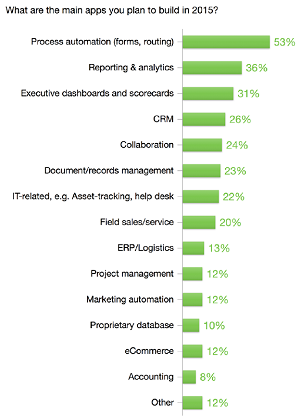News
Mobile Report: Native Development Trails Web, Hybrid
- By David Ramel
- April 27, 2015
The latest mobile development survey from OutSystems sheds further light on how companies are addressing the increasing importance of creating mobile apps, a business priority reaching "critical" status this year.
The rapid application development company said mobility -- creating mobile apps or Web sites that are mobile-friendly -- has emerged as a top focus of enterprises in 2015, with 43 percent of respondents rating it as the primary business functionality or process critical for applications. Also, polling more than 200 IT decision-makers in the State of Application Development Report -- conducted by TechValidate -- found that more than half are planning to create at least half their business apps with a mobile component.
While the increasing importance of mobility is no surprise, the survey also provides more fodder for the unending debate about approaches used to attain such mobility. Currently three approaches are most widely used: native development (which, these days, basically means targeting iOS and Android with separate projects); mobile Web development (using HTML5, CSS, JavaScript and so on for one cross-platform project); or hybrid (a cross-platform melding of the two approaches using various techniques -- such as thin wrappers over Web-tech apps or complete third-party platforms -- that promise to provide native functionality).
With most dev shops probably using a combination of approaches depending on the circumstances, the debate over the preferred techniques to use continues to roil, with different surveys finding different results.
 [Click on image for larger view.]
Top Apps Enterprises Plan To Build in 2015 (source: OutSystems)
[Click on image for larger view.]
Top Apps Enterprises Plan To Build in 2015 (source: OutSystems)
"While native allows developers to fully leverage device features and functionality, hybrid and mobile Web enable developers to build one application for use on multiple platforms," OutSystems said in its report. "This is a benefit for IT organizations that have lengthy development queues and need to satisfy a diverse user base -- and survey results indicate that they're taking advantage of that benefit. The majority of IT organizations report that the mobile architectures they intend to use the most this year are hybrid (65 percent) and mobile Web (60 percent)." Only 26 percent of 178 respondents reported using native architecture in the multiple-choice question.
But, as reported here last October, a previous OutSystems survey revealed different results:
"When asked about their preferred type of mobile app development environment, one-third voted for hybrid (33 percent), while 29 percent preferred native and 22 percent opted for HTML5/responsive design," OutSystems reported. "Sixteen percent stated that this would vary on a case-by-case basis."
And just a month earlier, a Telerik survey reported "Of those developing for mobile, the majority are focused on Web/HTML5, leaving native and hybrid app development neck-and-neck in terms of adoption."
However, even more surveys have found even more disparate results, showing how chaotic the mobile development field is right now, with each company trying to find the right approach for its needs and reaching little industry-wide consensus -- especially among the developers themselves.
To stir things up even more, upstart technologies have been added to the mix, such as the brand-new React Native project from Facebook engineers that relies on new JavaScript techniques to let enterprise developers conversant in React Native build an iOS app and then immediately use the same approach to build an Android app. So, instead of "write once, run anywhere" (an unobtainable "pipe dream," according to Facebook), it's a "learn once, write anywhere" approach.
And it's an approach that has some merit, according to IDC analyst Al Hilwa.
"IDC believes that React Native puts forward an important new paradigm for hybrid application development that liberates mobile developers form the confines of the much-maligned WebView component which is typically used with the Apache Cordova hybrid approach," Hilwa said in a research report recently. "By removing the dependency on the WebView, React Native essentially delivers native performance and opens the entire capability of the native device platform to the Web developer. React Native effectively redefines hybrid model mobile applications and application development."
That approach -- along with other new-age uses of JavaScript -- probably won't show up in surveys like these very soon, as Reach Native just recently was open sourced for iOS development, with the Android project lagging behind.
Enterprise mobility efforts are sure to maintain their momentum however, especially in light of the recent algorithmic changes made by Google that place more emphasis on "mobile-friendliness" in mobile search results -- a change with the potential to make or break some online companies.
In the meantime, the new OutSystems survey found that the actual apps to be created by developers -- using whatever approach -- are process automation projects, dealing with tasks such as handling forms and routing. Coming in at No. 2 -- in the age of cloud computing and Big Data -- are reporting and analytics apps, followed by executive dashboards/scorecards, customer relationship management (CRM) apps and collaboration apps, rounding out the top five.
The survey also found a significant need for back-end integration with numerous systems, in the cloud or on-premises.
"The survey results echo the challenges we hear from customers: they are increasingly focused on delivering mobile applications, they aren't getting what they need from off-the-shelf from packaged applications, and they desperately need the ability to integrate quickly and seamlessly with a wide variety of technologies," said OutSystems CEO Paulo Rosado in a statement. "This confluence of challenges within enterprise application development is leading organizations to seek alternatives to dramatically simplify the delivery of applications, regardless of the underlying technology requirements."
To that end, the company offered new functionality announced for its Rapid Application Delivery platform.
About the Author
David Ramel is an editor and writer at Converge 360.